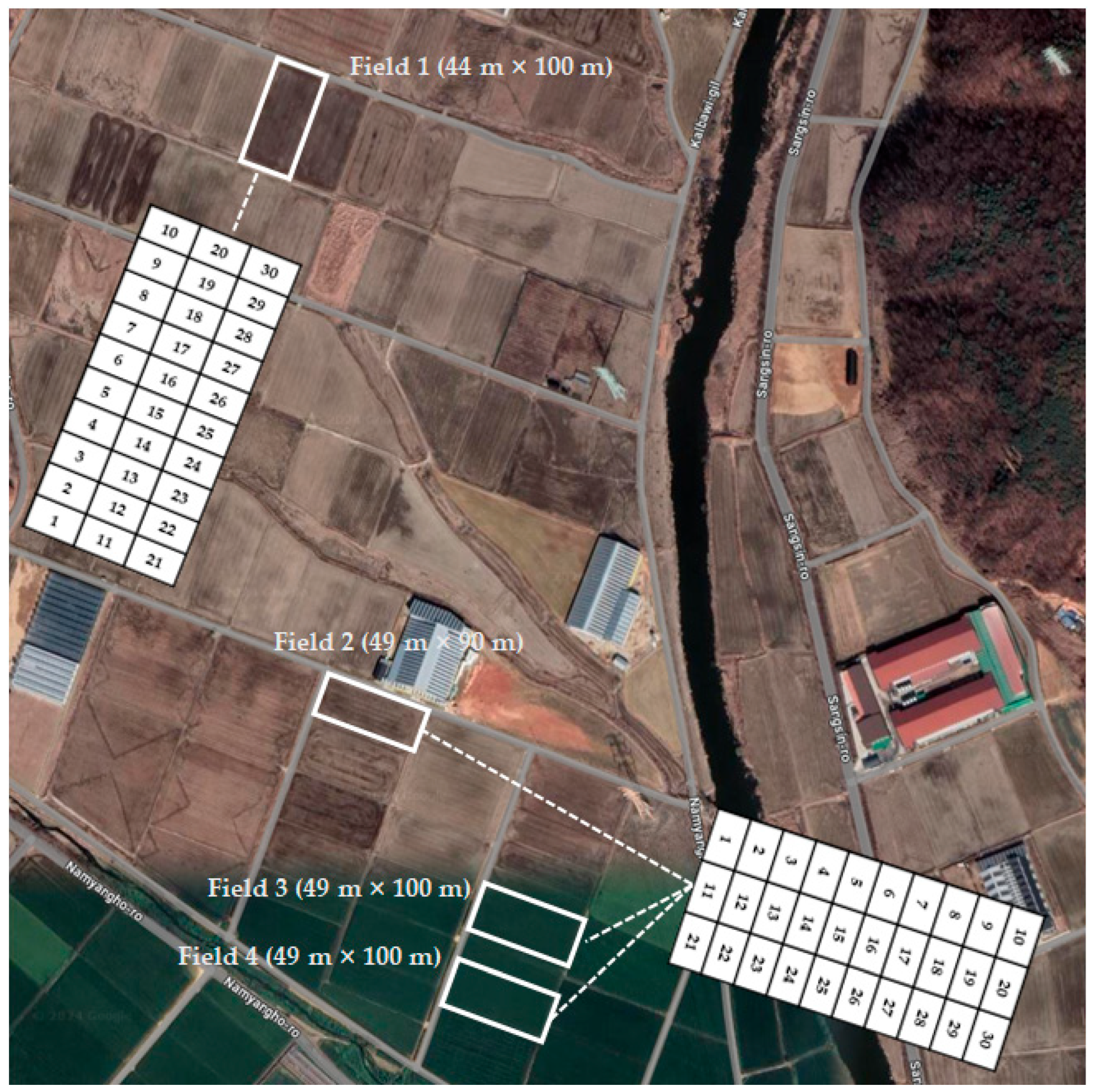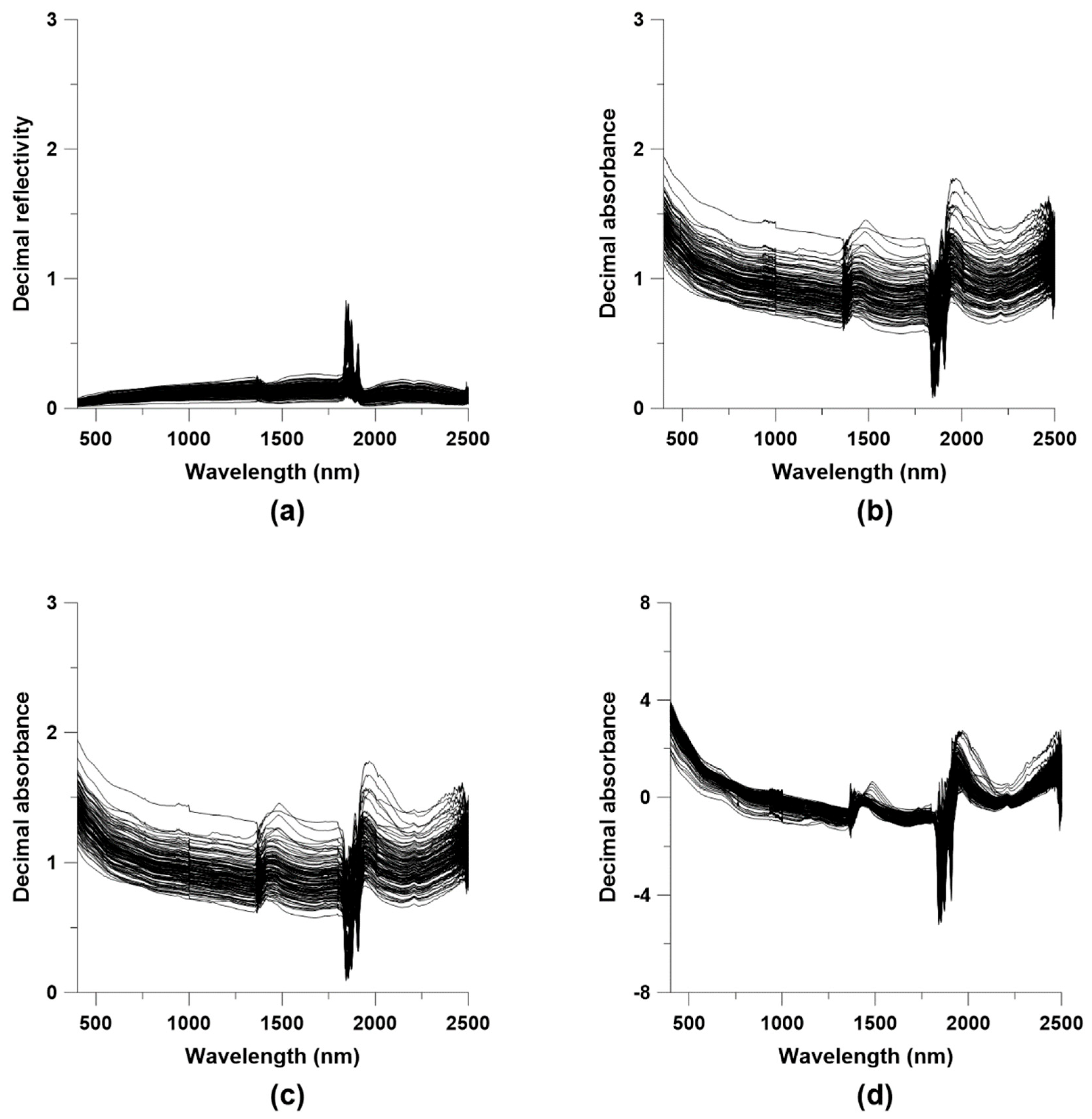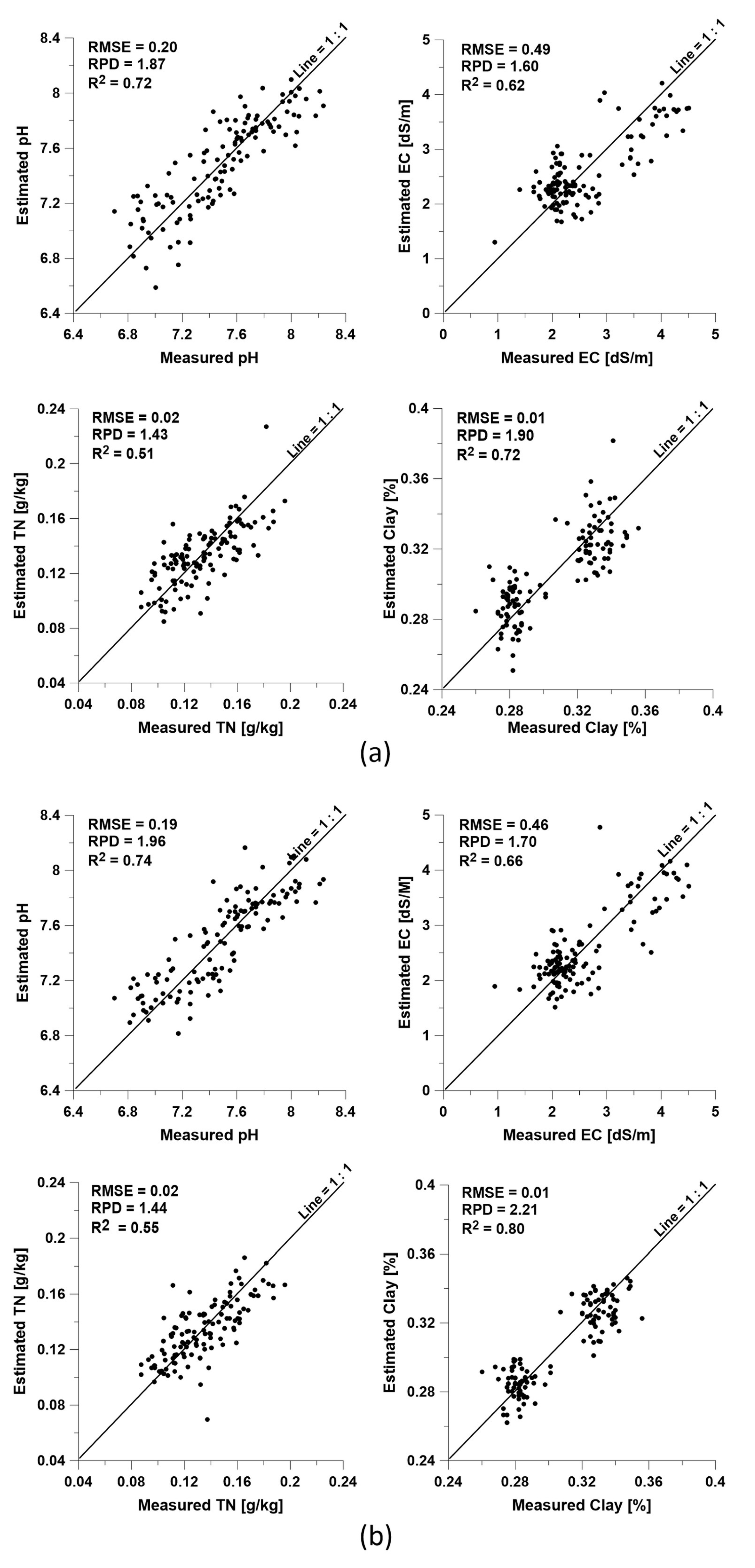A Preprocessing Technique Using Diffuse Reflectance Spectroscopy to Predict the Soil Properties of Paddy Fields in Korea
Abstract
1. Introduction
- Collect spectral data of soil in a wet state (wet soil) and soil in a dry state (dry soil) and develop a predictive regression model using PLSR analysis;
- Perform comparative analysis between the soil property prediction regression models using the preprocessing techniques of SG smoothing and SNV.
2. Materials and Methods
2.1. Soil Property Analysis and Spectral Measurements
2.2. Soil Spectrum Preprocessing
2.3. Analysis and Validation Methods
3. Results and Discussion
3.1. PLSR by Preprocessing Using Savitzky–Golay Smoothing
3.2. PLSR by Preprocessing Using the Standard Normal Variate
3.3. Comparison of Regression Models Predicting Soil Properties Using Preprocessing
4. Conclusions
Author Contributions
Funding
Institutional Review Board Statement
Informed Consent Statement
Data Availability Statement
Conflicts of Interest
References
- Heydari, L.; Bayat, H.; Castrignanò, A. Scale-dependent geostatistical modelling of crop-soil relationships in view of Precision Agriculture. Precis. Agric. 2023, 24, 1261–1287. [Google Scholar] [CrossRef]
- Kim, D. Development and Accuracy Evaluation of Field Soil Temperature Prediction Model by Depth Using Artificial Intelligence and Meteorological Parameters. Master’s Thesis, The Seoul National University, Seoul, Republic of Korea, 2002. [Google Scholar]
- Passioura, J. Soil conditions and plant growth. Plant Cell Environ. 2002, 25, 311–318. [Google Scholar] [CrossRef] [PubMed]
- Tahat, M.M.; Alananbeh, K.M.; Othman, Y.A.; Leskovar, D.I. Soil health and sustainable agriculture. Sustainability 2020, 12, 4859. [Google Scholar] [CrossRef]
- Yun, H.-W.; Choi, C.-H.; Kim, Y.-J.; Hong, S.-J. Development of real-time chemical properties analysis technique in paddy soil for precision farming. Korean J. Agric. Sci. 2014, 41, 59–63. [Google Scholar]
- Shin, K.-S.; Lim, W.-J.; Lee, S.E.; Lee, J.S.; Cha, G.S. Development of extracting solution for soil chemical analysis suitable to integrated ion-selective micro-electrodes. Korean J. Soil Sci. Fertil. 2009, 42, 513–521. [Google Scholar]
- Dalmolin, R.S.D.; Gonçalves, C.N.; Klamt, E.; Dick, D.P. Relationship between the soil constituents and its spectral behavior. Ciência Rural 2005, 35, 481–489. [Google Scholar] [CrossRef]
- Rossel, R.V.; Walvoort, D.; McBratney, A.; Janik, L.J.; Skjemstad, J. Visible, near infrared, mid infrared or combined diffuse reflectance spectroscopy for simultaneous assessment of various soil properties. Geoderma 2006, 131, 59–75. [Google Scholar] [CrossRef]
- Lee, K.; Lee, D.; Sudduth, K.; Chung, S.; Kitchen, N.; Drummond, S. Wavelength identification and diffuse reflectance estimation for surface and profile soil properties. Trans. ASABE 2009, 52, 683–695. [Google Scholar] [CrossRef]
- Mouazen, A.M.; De Baerdemaeker, J.; Ramon, H. Towards development of on-line soil moisture content sensor using a fibre-type NIR spectrophotometer. Soil Tillage Res. 2005, 80, 171–183. [Google Scholar] [CrossRef]
- Vestergaard, R.-J.; Vasava, H.B.; Aspinall, D.; Chen, S.; Gillespie, A.; Adamchuk, V.; Biswas, A. Evaluation of optimized preprocessing and modelling algorithms for prediction of soil properties using vis-NIR spectroscopy. Sensors 2021, 20, 6745. [Google Scholar] [CrossRef]
- Veum, K.S.; Parker, P.A.; Sudduth, K.A.; Holan, S.H. Predicting Profile Soil Properties with Reflectance Spectra via Bayesian Covariate-Assisted External Parameter Orthogonalization. Sensors 2018, 18, 3869. [Google Scholar] [CrossRef] [PubMed]
- Dangal, S.R.S.; Sanderman, J.; Wills, S.; Ramirez-Lopez, L. Accurate and precise prediction of soil properties from a large mid-infrared spectral library. Soil Syst. 2019, 3, 11. [Google Scholar] [CrossRef]
- Pei, X.; Sudduth, K.; Veum, K.; Li, M. Improving In-Situ Estimation of Soil Profile Properties Using a Multi-Sensor Probe. Sensors 2019, 19, 1011. [Google Scholar] [CrossRef] [PubMed]
- Qi, H.J.; Paz-Kagan, T.; Karnieli, A.; Li, S.W. Linear multi-task learning for predicting soil properties using field spectroscopy. Remote Sens. 2017, 9, 1099. [Google Scholar] [CrossRef]
- Dotto, A.C.; Dalmolin, R.S.D.; Grunwald, S.; ten Caten, A.; Pereira Filho, W. Two preprocessing techniques to reduce model covariables in soil property predictions by Vis-NIR spectroscopy. Soil Tillage Res. 2017, 172, 59–68. [Google Scholar] [CrossRef]
- Gholizadeh, A.; Amin, M.S.M.; Borůvka, L.; Saberioon, M.M. Models for estimating the physical properties of paddy soil using visible and near infrared reflectance spectroscopy. J. Appl. Spectrosc. 2014, 81, 534–540. [Google Scholar] [CrossRef]
- Conforti, M.; Matteucci, G.; Buttafuoco, G. Using laboratory Vis-NIR spectroscopy for monitoring some forest soil properties. J. Soils Sediments 2017, 18, 1009–1019. [Google Scholar] [CrossRef]
- Miloš, B.; Bensa, A.; Japundžić-Palenkić, B. Evaluation of Vis-NIR preprocessing combined with PLS regression for estimation soil organic carbon, cation exchange capacity and clay from eastern Croatia. Geoderma Reg. 2022, 30, e00558. [Google Scholar] [CrossRef]
- NAAS. Manual of Analysis Procedures for Comprehensive Test Lab; National Academy of Agricultural Science, Rural Development Administration: Suwon-si, Republic of Korea, 2017. [Google Scholar]
- Cho, Y.; Sheridan, A.H.; Sudduth, K.A.; Veum, K.S. Comparison of field and laboratory VNIR spectroscopy for profile soil property estimation. Trans. ASABE 2017, 60, 1503–1510. [Google Scholar] [CrossRef]
- Mouazen, A.M.; Karoui, R.; De Baerdemaeker, J.; Ramon, H. Characterization of soil water content using measured visible and near infrared spectra. Soil Sci. Soc. Am. J. 2006, 70, 1295–1302. [Google Scholar] [CrossRef]
- Bogrekci, I.; Lee, W. Effects of soil moisture content on absorbance spectra of sandy soils in sensing phosphorus concentrations using UV-VIS-NIR spectroscopy. Trans. ASABE 2006, 49, 1175–1180. [Google Scholar] [CrossRef]
- Weidong, L.; Baret, F.; Xingfa, G.; Qingxi, T.; Lanfen, Z.; Bing, Z. Relating soil surface moisture to reflectance. Remote Sens. Environ. 2002, 81, 238–246. [Google Scholar] [CrossRef]
- ASAE Standard S358 2(DEC93); Moisture Measurement—Forages. ASAE: Washington, DC, USA, 2012.
- Joo, H. Prediction of Soil Properties in Paddy Soil Using Sensor Fusion Data. Master’s Thesis, The Jeonbuk National University, Jeonju, Republic of Korea, 2023. [Google Scholar]
- Rinnan, Å.; Van Den Berg, F.; Engelsen, S.B. Review of the most common pre-processing techniques for near-infrared spectra. TrAC Trends Anal. Chem. 2009, 28, 1201–1222. [Google Scholar] [CrossRef]
- Mishra, P.; Biancolillo, A.; Roger, J.M.; Marini, F.; Rutledge, D.N. New data preprocessing trends based on ensemble of multiple preprocessing techniques. TrAC Trends Anal. Chem. 2020, 132, 116045. [Google Scholar] [CrossRef]
- Gholizadeh, A.; Borůvka, L.; Saberioon, M.M.; Kozák, J.; Vašát, R.; Němeček, K. Comparing different data preprocessing methods for monitoring soil heavy metals based on soil spectral features. Soil Water Res. 2015, 10, 218–227. [Google Scholar] [CrossRef]
- Savitzky, A.; Golay, M.J. Smoothing and differentiation of data by simplified least squares procedures. Anal. Chem. 1964, 36, 1627–1639. [Google Scholar] [CrossRef]
- Vibhute, A.D.; Kale, K.V.; Mehrotra, S.C.; Dhumal, R.K.; Nagne, A.D. Determination of soil physicochemical attributes in farming sites through visible, near-infrared diffuse reflectance spectroscopy and PLSR modeling. Ecol. Process. 2018, 7, 1–12. [Google Scholar] [CrossRef]
- Shi, X.; Yao, L.; Pan, T. Visible and near-infrared spectroscopy with multi-parameters optimization of Savitzky-Golay smoothing applied to rapid analysis of soil cr content of pearl river delta. J. Geosci. Environ. Prot. 2021, 9, 75. [Google Scholar] [CrossRef]
- Barnes, R.; Dhanoa, M.S.; Lister, S.J. Standard normal variate transformation and de-trending of near-infrared diffuse reflectance spectra. Appl. Spectrosc. 1989, 43, 772–777. [Google Scholar] [CrossRef]
- Wold, H. Systems Analysis by Partial Least Squares. In Measuring the Unmeasurable; Nijkamp, P., Leitner, H., Wrigley, N., Eds.; Martinus Nijhoff Publishers: Dordrecht, The Netherlands, 1985; pp. 221–251. [Google Scholar]
- Cozzolino, D.; Moron, A. The potential of near-infrared reflectance spectroscopy to analyse soil chemical and physical characteristics. J. Agric. Sci. 2003, 140, 65–71. [Google Scholar] [CrossRef]
- P Leone, A.; A Viscarra-Rossel, R.; Amenta, P.; Buondonno, A. Prediction of soil properties with PLSR and vis-NIR spectroscopy: Application to mediterranean soils from Southern Italy. Curr. Anal. Chem. 2012, 8, 283–299. [Google Scholar] [CrossRef]
- Nawar, S.; Buddenbaum, H.; Hill, J. Digital mapping of soil properties using multivariate statistical analysis and ASTER data in an arid region. Remote Sens. 2015, 7, 1181–1205. [Google Scholar] [CrossRef]
- Gomez, C.; Lagacherie, P.; Coulouma, G. Regional predictions of eight common soil properties and their spatial structures from hyperspectral Vis–NIR data. Geoderma 2012, 189, 176–185. [Google Scholar] [CrossRef]
- Cho, Y.; Sudduth, K.A.; Drummond, S.T. Profile soil property estimation using a VIS-NIR-EC-force probe. Trans. ASABE 2017, 60, 683–692. [Google Scholar] [CrossRef]
- Chang, C.-W.; Laird, D.A.; Mausbach, M.J.; Hurburgh, C.R. Near-infrared reflectance spectroscopy–principal components regression analyses of soil properties. Soil Sci. Soc. Am. J. 2001, 65, 480–490. [Google Scholar] [CrossRef]





| Soil Sample Data | All Fields | Field 1 | Field 2 | Field 3 | Field 4 | |||||
|---|---|---|---|---|---|---|---|---|---|---|
| Mean (n = 120) | SD (n = 120) | Mean (n = 30) | SD (n = 30) | Mean (n = 30) | SD (n = 30) | Mean (n = 30) | SD (n = 30) | Mean (n = 30) | SD (n = 30) | |
| pH | 7.48 | 0.37 | 7.17 | 0.24 | 7.21 | 0.24 | 7.64 | 0.13 | 7.89 | 0.21 |
| EC [dS/m] | 2.57 | 0.78 | 3.78 | 0.44 | 2.29 | 0.29 | 2.09 | 0.33 | 2.13 | 0.29 |
| SOM [g/kg] | 32.09 | 5.36 | 32.15 | 3.97 | 38.54 | 4.05 | 29.91 | 3.00 | 27.77 | 3.05 |
| TN [g/kg] | 0.13 | 0.02 | 0.16 | 0.02 | 0.13 | 0.002 | 0.13 | 0.01 | 0.11 | 0.01 |
| TOC [%] | 1.86 | 0.31 | 1.86 | 0.23 | 2.24 | 0.23 | 1.74 | 0.17 | 1.61 | 1.78 |
| Clay [%] | 30.66 | 0.03 | 33.26 | 0.01 | 30.61 | 0.03 | 28.27 | 0.01 | 30.48 | 0.03 |
| Soil Properties | Spectral Band 1 | No.F 2 | R2C 3 | RMSEC 4 | R2P 5 | RMSEP 6 | RPD | |
|---|---|---|---|---|---|---|---|---|
| Dried Soil | pH | VIS | 7 | 0.81 | 0.16 | 0.72 | 0.20 | 1.87 |
| NIR | 7 | 0.69 | 0.20 | 0.51 | 0.26 | 1.43 | ||
| EC [dS/m] | VIS | 4 | 0.64 | 0.47 | 0.62 | 0.49 | 1.60 | |
| NIR | 5 | 0.54 | 0.53 | 0.41 | 0.60 | 1.30 | ||
| SOM [g/kg] | VIS | 6 | 0.56 | 3.53 | 0.47 | 3.88 | 1.38 | |
| NIR | 4 | 0.37 | 4.22 | 0.26 | 4.59 | 1.17 | ||
| TN [g/kg] | VIS | 6 | 0.64 | 0.01 | 0.51 | 0.02 | 1.43 | |
| NIR | 5 | 0.49 | 0.02 | 0.37 | 0.02 | 1.26 | ||
| TOC [%] | VIS | 6 | 0.56 | 0.20 | 0.49 | 0.22 | 1.39 | |
| NIR | 3 | 0.32 | 0.25 | 0.28 | 0.27 | 1.16 | ||
| Clay [%] | VIS | 7 | 0.77 | 0.01 | 0.64 | 0.02 | 1.67 | |
| NIR | 7 | 0.79 | 0.01 | 0.72 | 0.01 | 1.90 | ||
| Wet Soil | pH | VIS | 7 (5) 7 | 0.39 (0.31) | 0.29 (0.30) | 0.19 (0.25) | 0.34 (0.32) | 1.09 (1.13) |
| NIR | 7 (4) | 0.58 (0.43) | 0.28 (0.28) | 0.27 (0.38) | 0.32 (0.29) | 1.16 (1.26) | ||
| EC [dS/m] | VIS | 4 (5) | 0.25 (0.28) | 0.68 (0.66) | 0.19 (0.20) | 0.71 (0.71) | 1.09 (1.10) | |
| NIR | 5 (3) | 0.35 (0.24) | 0.63 (0.68) | 0.19 (0.20) | 0.71 (0.70) | 1.11 (1.11) | ||
| SOM [g/kg] | VIS | 6 | 0.40 | 4.17 | 0.12 | 5.07 | 1.06 | |
| NIR | 4 (2) | 0.32 (0.17) | 4.40 (4.85) | 0.09 (0.12) | 5.10 (5.02) | 1.05 (1.07) | ||
| TN [g/kg] | VIS | 6 (3) | 0.27 (0.19) | 0.02 (0.02) | 0.13 (0.15) | 0.02 (0.02) | 1.09 (1.07) | |
| NIR | 5 (5) | 0.42 | 0.02 | 0.29 | 0.02 | 1.18 | ||
| TOC [%] | VIS | 6 (3) | 0.17 (0.10) | 0.28 (0.29) | 0.02(0.05) | 0.31 (0.30) | 1.01 (1.03) | |
| NIR | 3 (2) | 0.24 (0.17) | 0.27 (0.28) | 0.07(0.13) | 0.30 (0.29) | 1.03 (1.07) | ||
| Clay [%] | VIS | 7 (6) | 0.46 (0.43) | 0.02 (0.02) | 0.24 (0.25) | 0.02 (0.02) | 1.15 (1.15) | |
| NIR | 7 (4) | 0.56 (0.43) | 0.02(0.36) | 0.02(0.23) | 0.02 (0.02) | 1.12 (1.23) | ||
| Soil Properties | Spectral Band 1 | No.F 2 | R2C 3 | RMSEC 4 | R2P 5 | RMSEP 6 | RPD | |
|---|---|---|---|---|---|---|---|---|
| Dried Soil | pH | VIS | 7 | 0.81 | 0.16 | 0.74 | 0.19 | 1.96 |
| NIR | 4 | 0.60 | 0.21 | 0.49 | 0.26 | 1.40 | ||
| EC [dS/m] | VIS | 7 | 0.76 | 0.38 | 0.66 | 0.46 | 1.70 | |
| NIR | 6 | 0.67 | 0.45 | 0.41 | 0.60 | 1.31 | ||
| SOM [g/kg] | VIS | 5 | 0.53 | 3.64 | 0.42 | 4.09 | 1.31 | |
| NIR | 7 | 0.63 | 3.23 | 0.29 | 4.61 | 1.16 | ||
| TN [g/kg] | VIS | 6 | 0.69 | 0.01 | 0.55 | 0.02 | 1.44 | |
| NIR | 3 | 0.41 | 0.02 | 0.32 | 0.02 | 1.20 | ||
| TOC [%] | VIS | 5 | 0.53 | 0.21 | 0.44 | 0.24 | 1.32 | |
| NIR | 3 | 0.31 | 0.26 | 0.26 | 0.27 | 1.16 | ||
| Clay [%] | VIS | 6 | 0.84 | 0.01 | 0.80 | 0.01 | 2.21 | |
| NIR | 5 | 0.79 | 0.01 | 0.66 | 0.02 | 1.72 | ||
| Wet Soil | pH | VIS | 7 (5) 7 | 0.38 (0.32) | 0.29 (0.30) | 0.22 (0.24) | 0.33 (0.33) | 1.11 (1.13) |
| NIR | 4 (3) | 0.46 (0.44) | 0.27 (0.27) | 0.29 (0.31) | 0.31 (0.31) | 1.17 (1.19) | ||
| EC [dS/m] | VIS | 7 (6) | 0.35 (0.35) | 0.63 (0.63) | 0.23 (0.23) | 0.69 (0.69) | 1.13 (1.13) | |
| NIR | 6 (2) | 0.51 (0.24) | 0.55 (0.68) | 0.06 (0.19) | 0.77 (0.71) | 1.02 (1.10) | ||
| SOM [g/kg] | VIS | 5 (3) | 0.16 (0.15) | 4.88 (4.93) | 0.09 (0.09) | 5.18 (5.15) | 1.03 (1.04) | |
| NIR | 7 (2) | 0.37 (0.21) | 4.24 (4.75) | 0.14 (0.17) | 5.08 (4.97) | 1.05 (1.08) | ||
| TN [g/kg] | VIS | 6 (6) | 0.30 | 0.02 | 0.23 | 0.02 | 1.14 | |
| NIR | 3 (2) | 0.39 (0.27) | 0.02 (0.02) | 0.21 (0.23) | 0.02 (0.02) | 1.11 (1.13) | ||
| TOC [%] | VIS | 5 (2) | 0.15 (0.09) | 0.29 (0.29) | 0.03 (0.04) | 0.31 (0.31) | 1.00 (1.01) | |
| NIR | 3 (3) | 0.34 | 0.25 | 0.18 | 0.28 | 1.10 | ||
| Clay [%] | VIS | 6 (5) | 0.45 (0.40) | 0.02 (0.02) | 0.31(0.33) | 0.02 (0.02) | 1.19 (1.21) | |
| NIR | 5 (4) | 0.55 (0.49) | 0.02 (0.02) | 0.32 (0.38) | 0.02 (0.02) | 1.19 (1.24) | ||
Disclaimer/Publisher’s Note: The statements, opinions and data contained in all publications are solely those of the individual author(s) and contributor(s) and not of MDPI and/or the editor(s). MDPI and/or the editor(s) disclaim responsibility for any injury to people or property resulting from any ideas, methods, instructions or products referred to in the content. |
© 2024 by the authors. Licensee MDPI, Basel, Switzerland. This article is an open access article distributed under the terms and conditions of the Creative Commons Attribution (CC BY) license (https://creativecommons.org/licenses/by/4.0/).
Share and Cite
Shin, J.; Kim, D.-C.; Cho, Y.; Yang, M.; Cho, W.-J. A Preprocessing Technique Using Diffuse Reflectance Spectroscopy to Predict the Soil Properties of Paddy Fields in Korea. Appl. Sci. 2024, 14, 4673. https://doi.org/10.3390/app14114673
Shin J, Kim D-C, Cho Y, Yang M, Cho W-J. A Preprocessing Technique Using Diffuse Reflectance Spectroscopy to Predict the Soil Properties of Paddy Fields in Korea. Applied Sciences. 2024; 14(11):4673. https://doi.org/10.3390/app14114673
Chicago/Turabian StyleShin, Juwon, Dae-Cheol Kim, Yongjin Cho, Myongkyoon Yang, and Woo-Jae Cho. 2024. "A Preprocessing Technique Using Diffuse Reflectance Spectroscopy to Predict the Soil Properties of Paddy Fields in Korea" Applied Sciences 14, no. 11: 4673. https://doi.org/10.3390/app14114673
APA StyleShin, J., Kim, D.-C., Cho, Y., Yang, M., & Cho, W.-J. (2024). A Preprocessing Technique Using Diffuse Reflectance Spectroscopy to Predict the Soil Properties of Paddy Fields in Korea. Applied Sciences, 14(11), 4673. https://doi.org/10.3390/app14114673










